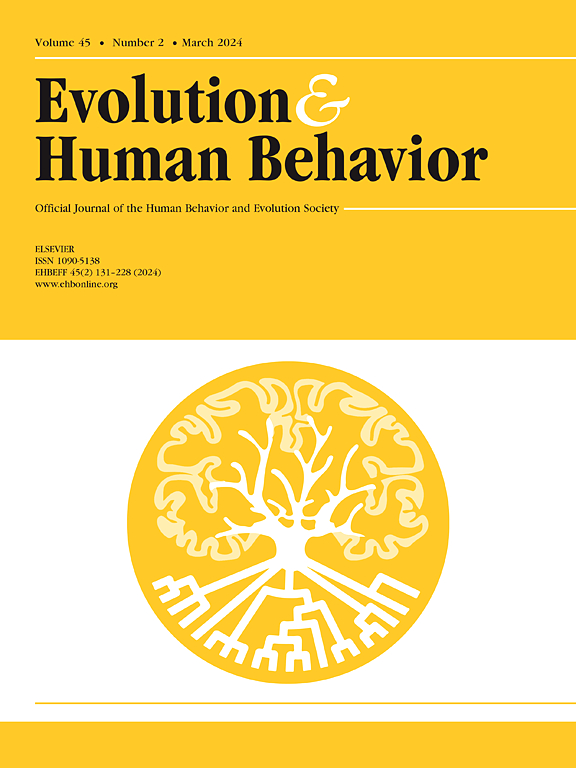口服避孕药和女性对面部阳刚和对称的偏好:来自双盲随机对照试验的证据
IF 3.2
1区 心理学
Q1 BEHAVIORAL SCIENCES
引用次数: 0
摘要
几项研究表明,异性恋女性对男性面孔的偏好随着月经周期中荷尔蒙的波动而变化,女性在排卵期或不使用激素避孕药时往往更喜欢男性面孔。虽然这已经通过观察数据进行了测试,但我们提供了第一个双盲随机对照研究,测试口服避孕药是否会降低人们对面部阳刚和对称的偏好。340名妇女被随机分为口服避孕药组和安慰剂组,她们的面部偏好在基线和3个月后被测量。所有分析都遵循预先注册的预分析计划。没有发现口服避孕药对面部阳刚之气或面部对称的影响有统计学意义。在预先登记的探索性分析中,我们进一步发现月经周期阶段或激素水平与面部偏好之间没有统计学上显著的关联。这些结果提供了反对口服避孕药对女性偏爱男性化和对称脸的因果效应的证据,尽管我们的结果应该谨慎解释,因为我们只发现了反对效应大于0.4科恩d单位的有力证据。本文章由计算机程序翻译,如有差异,请以英文原文为准。
Oral contraceptives and women's preferences for facial masculinity and symmetry: Evidence from a double-blind randomized controlled trial
Several studies have reported that heterosexual women's preferences for male faces vary with hormonal fluctuations over the menstrual cycle and that women tend to prefer more masculine faces during ovulation or when not using hormonal contraceptives. While this has been tested using observational data, we provide the first double-blind randomized controlled study testing if oral contraceptives reduce preferences for facial masculinity and symmetry. Three hundred and forty women were randomized to either oral contraceptives or placebo and their facial preferences were measured at baseline and after 3 months. All analyses follow a pre-registered pre-analysis plan. No statistically significant effect of oral contraceptives on preferences for facial masculinity or facial symmetry was found. In pre-registered exploratory analyses, we further find no statistically significant associations between menstrual cycle phase or hormone levels and facial preferences. These results provide evidence against a causal effect of oral contraceptives on women's preferences for masculine and symmetric faces, although our results should be interpreted cautiously as we only find strong evidence against effect sizes larger than about 0.4 Cohen's d units.
求助全文
通过发布文献求助,成功后即可免费获取论文全文。
去求助
来源期刊

Evolution and Human Behavior
生物-行为科学
CiteScore
8.30
自引率
9.80%
发文量
62
审稿时长
82 days
期刊介绍:
Evolution and Human Behavior is an interdisciplinary journal, presenting research reports and theory in which evolutionary perspectives are brought to bear on the study of human behavior. It is primarily a scientific journal, but submissions from scholars in the humanities are also encouraged. Papers reporting on theoretical and empirical work on other species will be welcome if their relevance to the human animal is apparent.
 求助内容:
求助内容: 应助结果提醒方式:
应助结果提醒方式:


